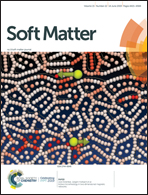Complex-type N-glycans on VSV-G pseudotyped HIV exhibit ‘tough’ sialic and ‘brittle’ mannose self-adhesions†
Abstract
The complex-type glycan shields of eukaryotic cells have a core layer of mannose residues buried under tiers of sugars that end with sialic acid (SA) residues. We investigate if the self-latching of mannose residues, earlier reported in pure monolayer studies, also manifests in the setting of a complex-type glycan shield. Would distal SA residues impede access to the mannose core? The interactions of mannobiose-, SA-, and lactose-coated probes with the complex-type VSV-G glycan shield on an HIV pseudovirus were studied with force-spectroscopy and gold-nanoparticle solutions. In force spectroscopy, the sugar probes can be forced to sample the depths of the glycan shield, whereas with sugar-coated nanoparticles, only interactions permitted by freely-diffusive contact occur. Deep-indentation mechanics was performed to verify the inferred structure of the engineered virus and to isolate the glycan shield layer for subsequent interaction studies. The adhesion between the sugar-probes and complex-type glycan shield was deconvoluted by comparing against the cross- and self- adhesions between the sugars in pure monolayers. Results from complementing systems were consistent with mannobiose-coated probes latching to the mannose core in the glycan shield, unhindered by the SA and distal sugars, with a short-range ‘brittle’ release of adhesion resulting in tightly coated viruses. SA-Coated probes, however, adhere to the terminal SA layer of a glycan shield with long-range and mechanically ‘tough’ adhesions resulting in large-scale virus aggregation. Lactose-coated probes exhibit ill-defined adherence to sialic residues. The selection and positioning of sugars within a glycan shield can influence how carbohydrate surfaces of different composition adhere.



 Please wait while we load your content...
Please wait while we load your content...
